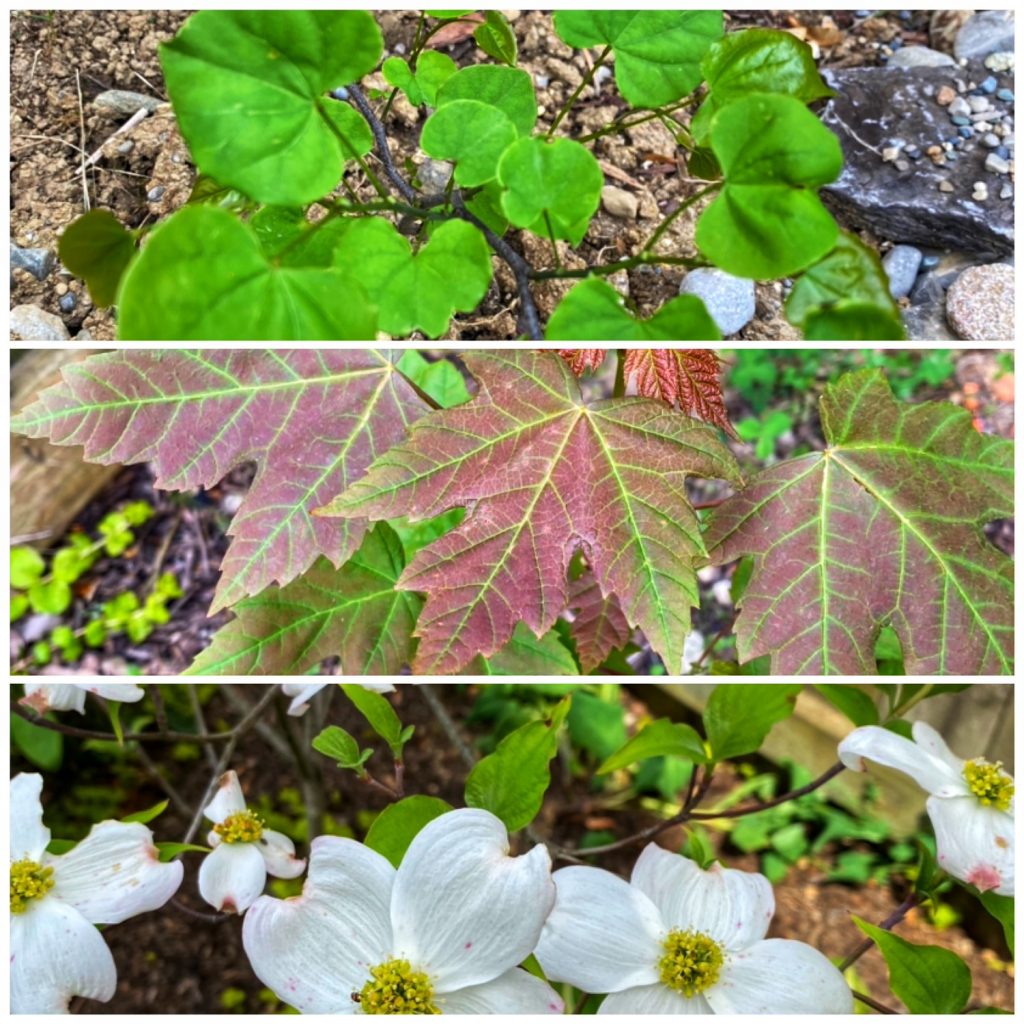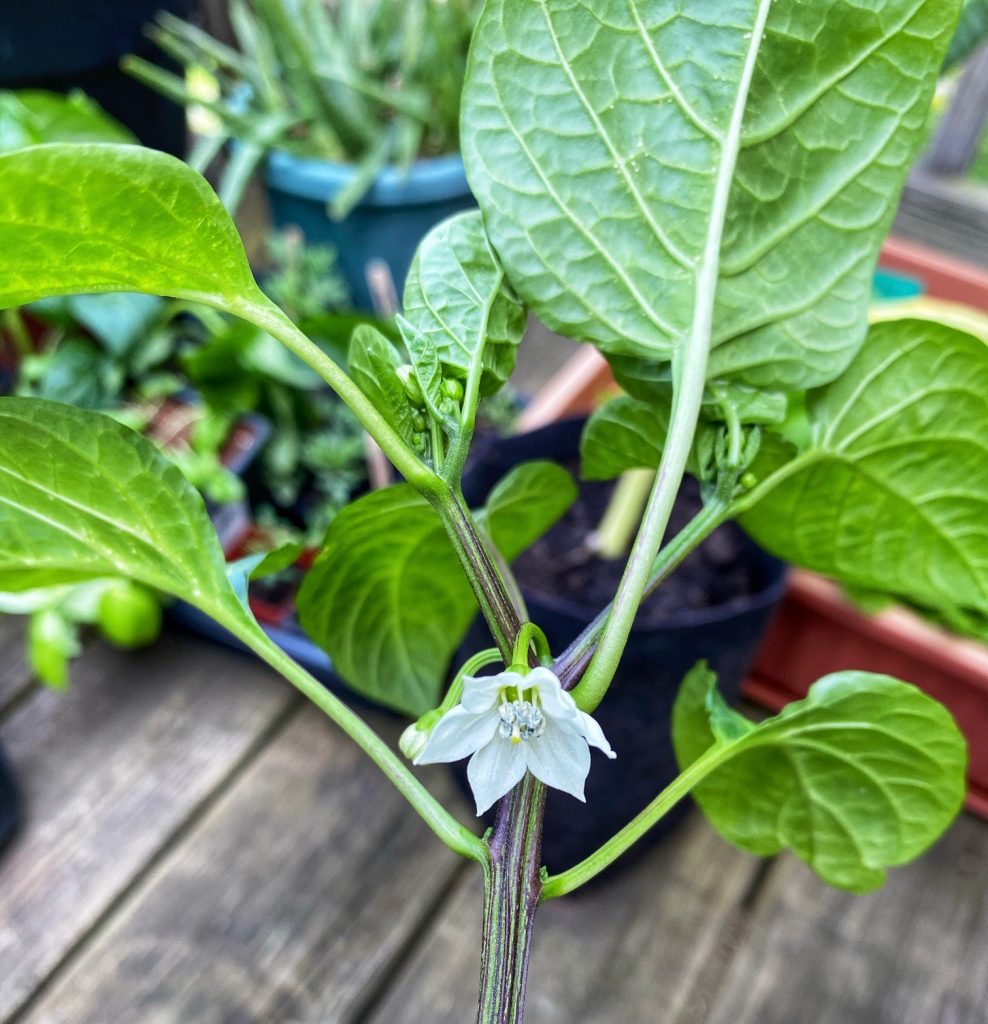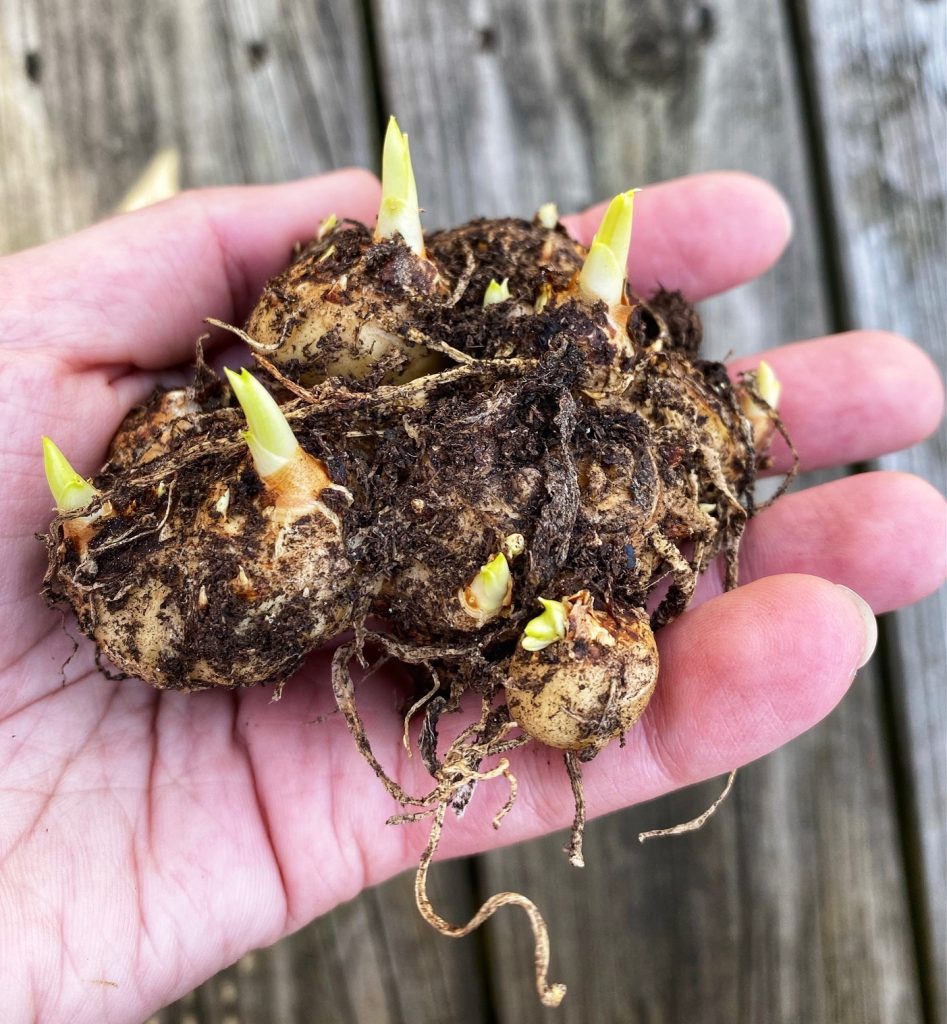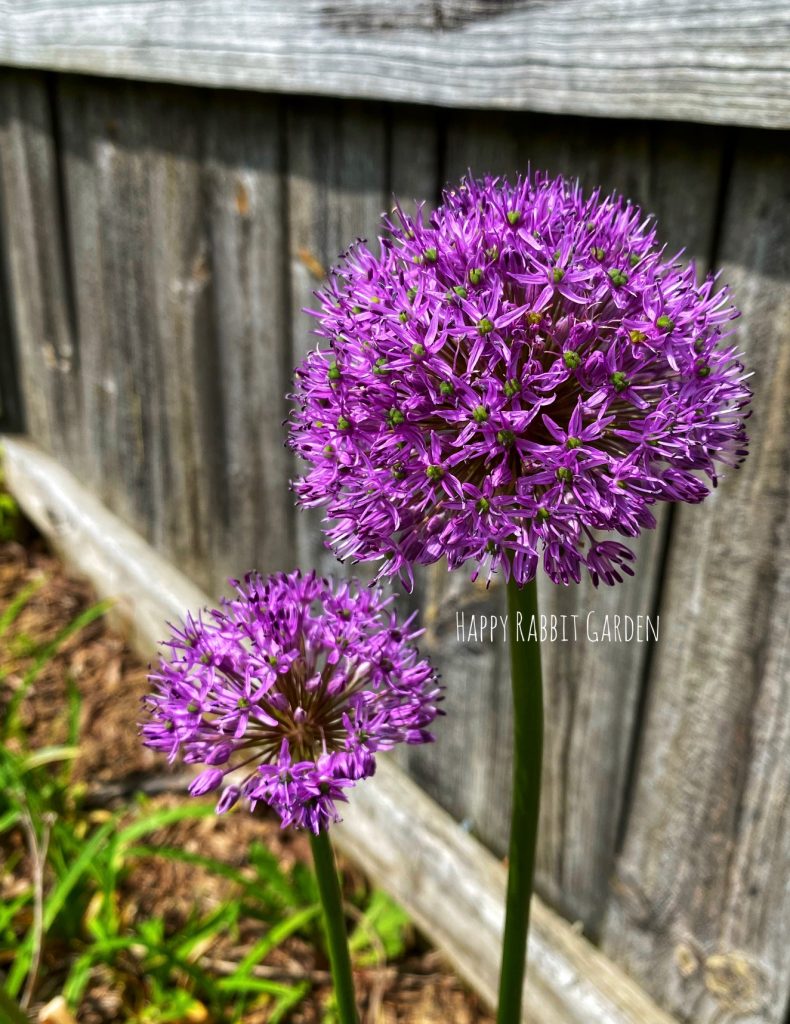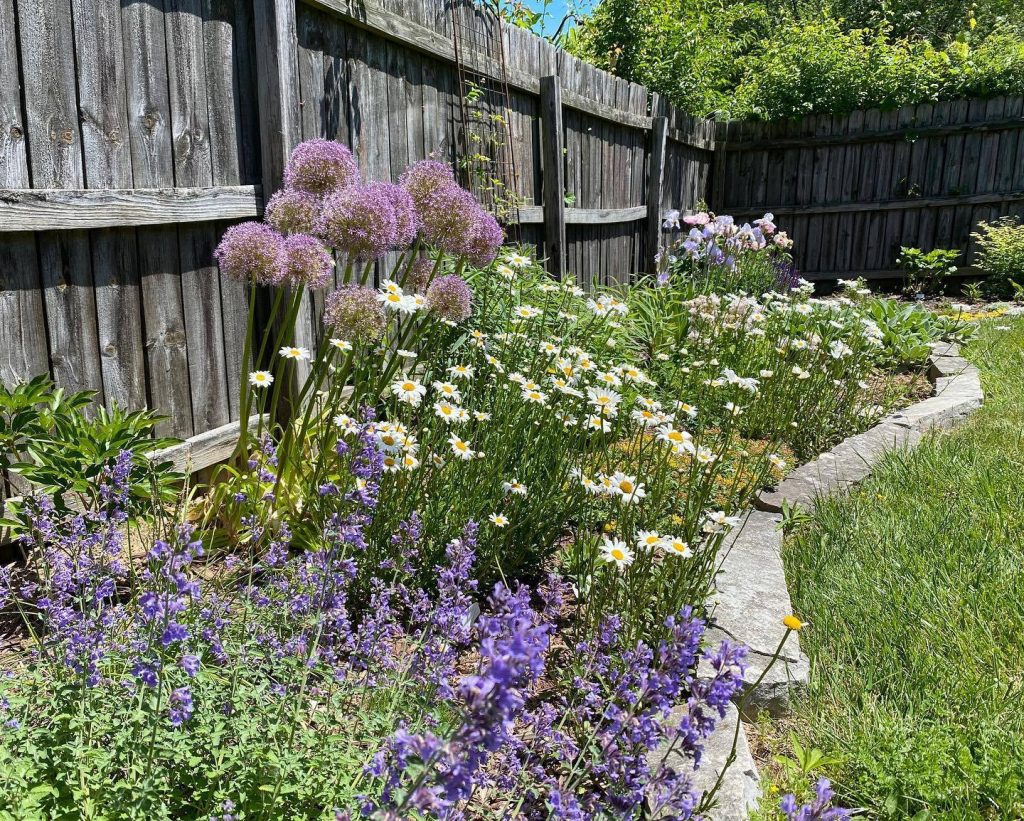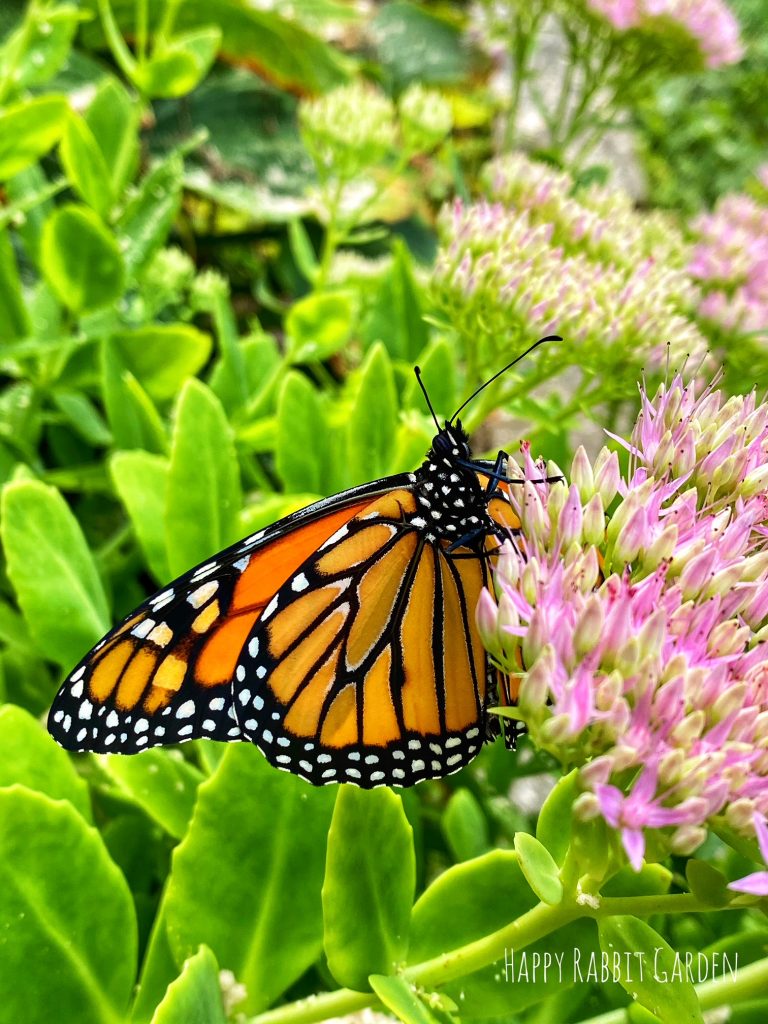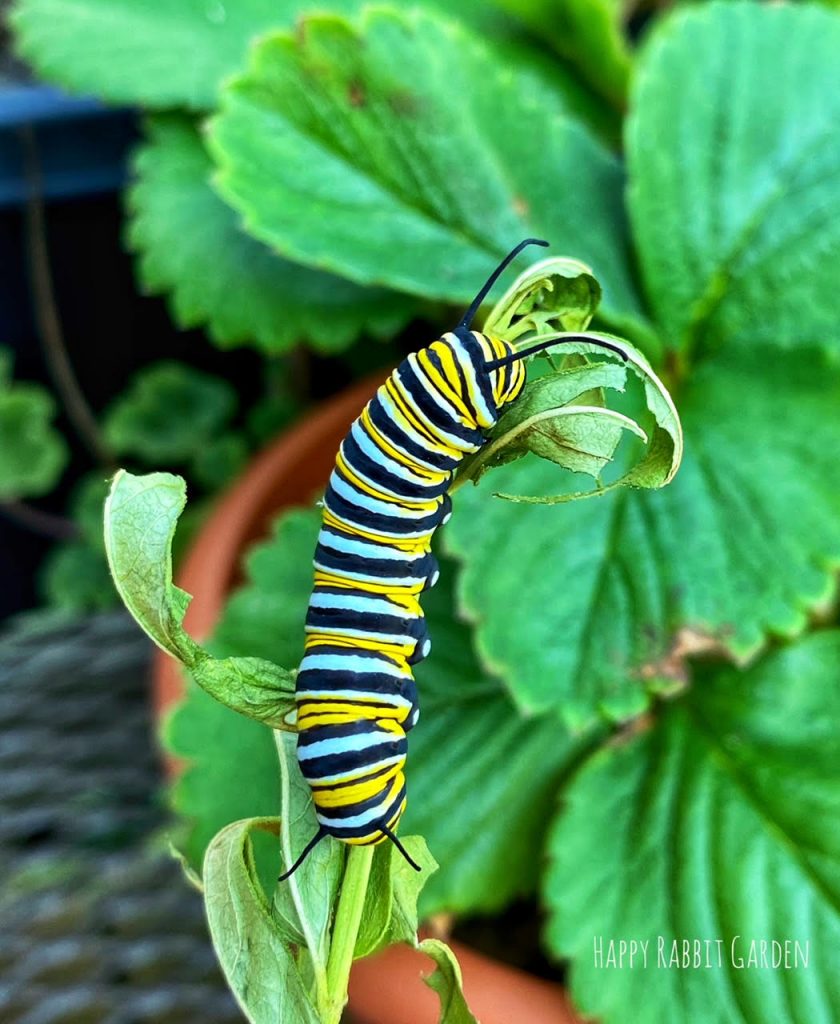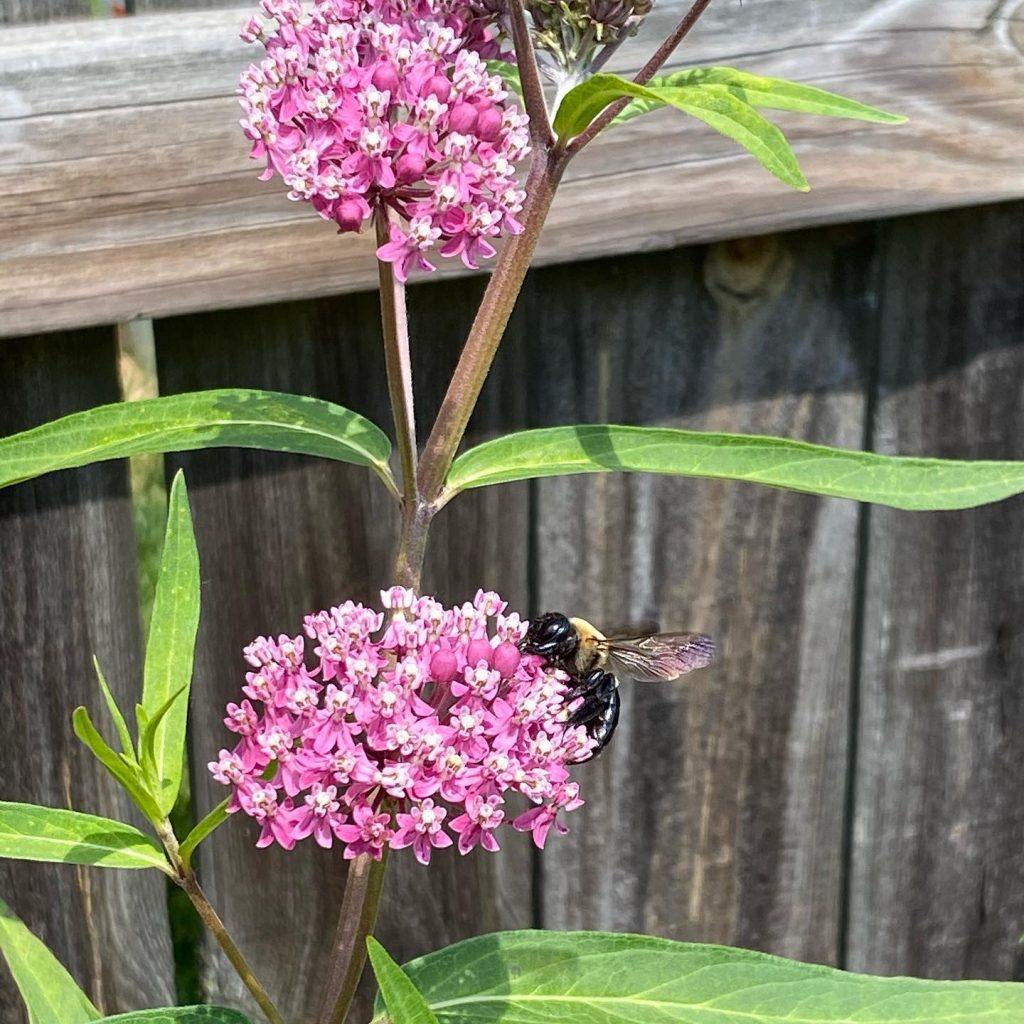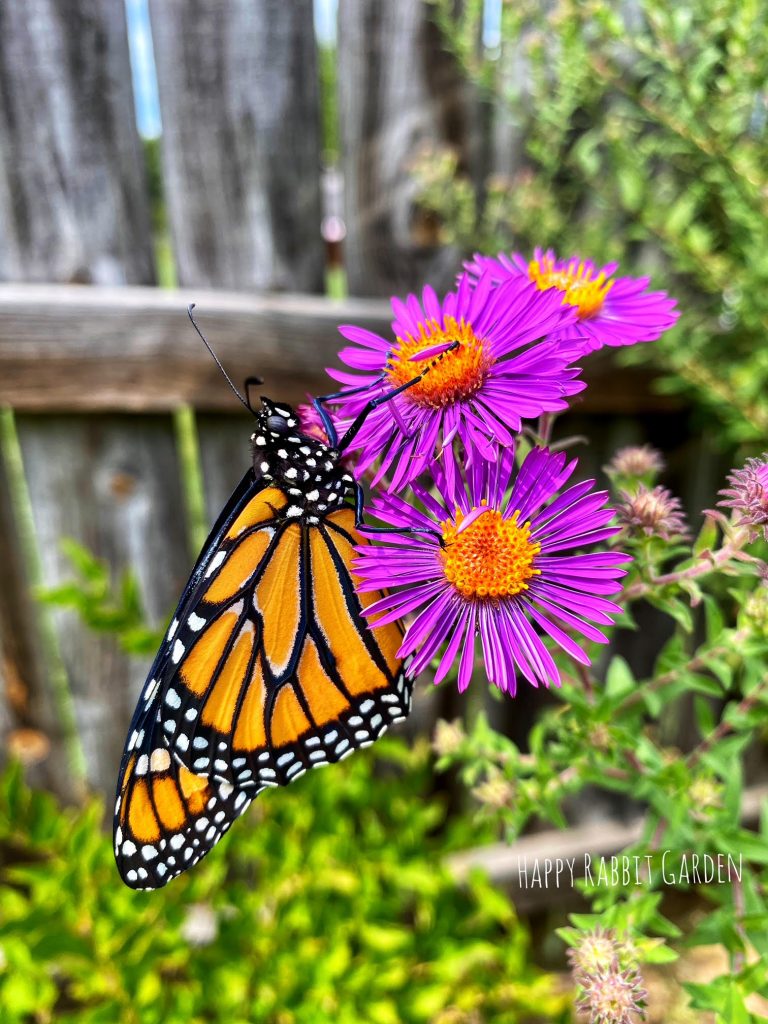I sometimes think our favorite pastime in Ohio is complaining about the weather. As a lifelong resident of this state, I’m well trained in the art of turning any conversation into a rant about the temperature. Today’s post will be no exception. As readers of this blog know, I grew a bumper crop of peppers and tomatoes from seed this year. They’ve been cruising along inside, under grow lights, and once the last chance of frost hit for the season, I started hardening the plants off outdoors. I had hoped to plant everything out in the garden last week, but the temps were in the 40s and 50s, which is much chillier than tomatoes enjoy for a high. And, it’s been raining buckets.
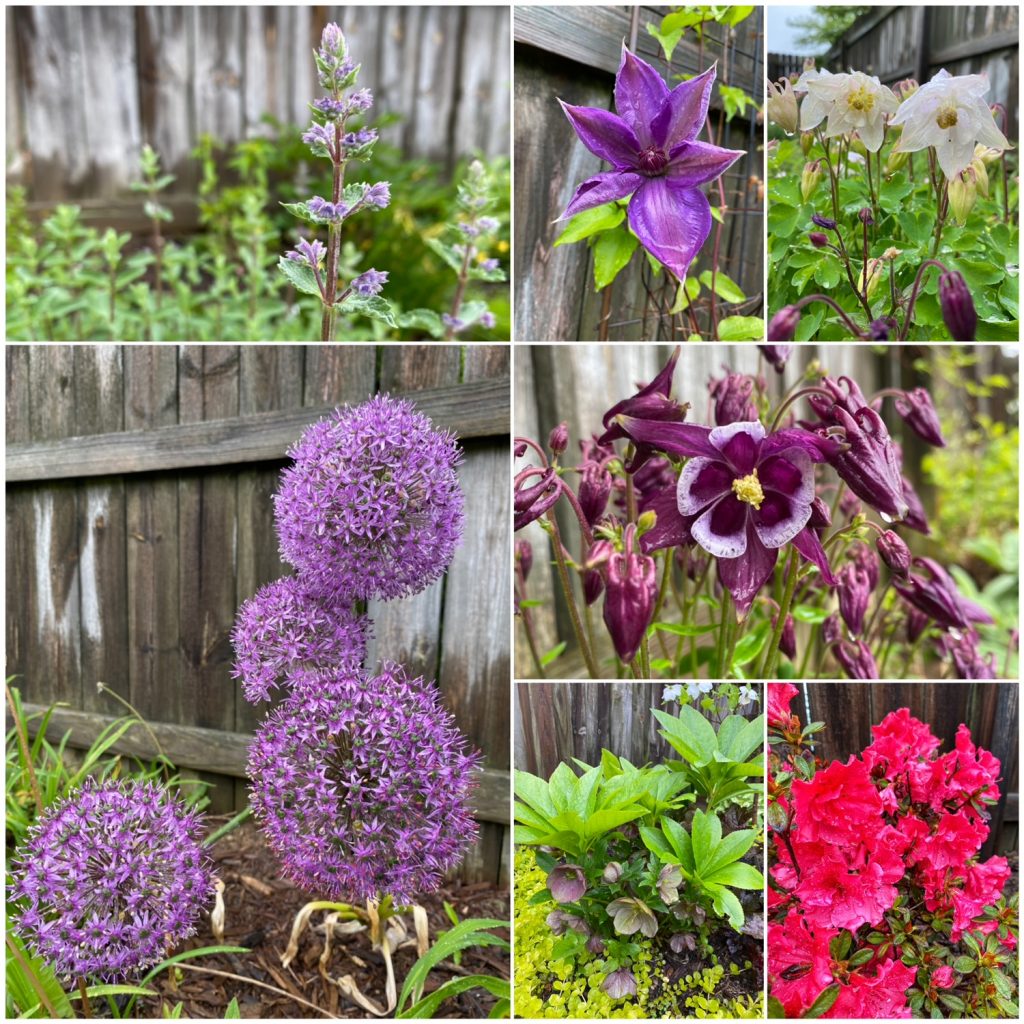
Our nepeta, clematis, columbines, allium, hellebores, and azaleas are all enjoying springtime.
This weekend, as I gazed morosely out the bay window in the kitchen, the storms continued. Yesterday alone, we had a few inches of rain. The ground is a muddy mess, with flooding and puddles all over the city. The calendar claims that we’re moving into the second week of May, but with temps 20 degrees below normal, it really doesn’t feel like it. Crabby gardener (me) is crabby.
I’m hoping to get everything planted later this week. The skies are supposed to clear, and it will be a little warmer out in a few days. I’m ready for everything to be in the ground already, and out onto the deck. Our kitchen has gone Full Jungle and while “grow lights hanging from your kitchen chandelier” is certainly a look, I’m not totally sure it’s one that will catch on with interior decorators any time soon.
Anyway. Three paragraphs is probably long enough of a weather rant today. I haven’t cussed out any meteorologists, but I hope I’ve managed to hang on to my Midwesterner cred anyway. So. Moving on.

I was weeding the asparagus bed and found this guy growing… I dug it up and was surprised to see that it’s a walnut sapling! The squirrels must have planted it. I repotted it so it can keep growing on the deck.
Last week, I acquired quite a few new plants for the garden. I ordered some native plants from Prairie Nursery the other month, and they arrived a few days ago. I was pretty impressed with the packaging- all of the plants were healthy and happy, and nothing was smashed to bits by the delivery company. I’ve been working on pulling up some more grass around the new wildlife pond, and so I was able to plant the new maidenhair ferns, canada anemones, jack in the pulpits, creek sedge, northern sea oats, and wild geraniums there. All of the plants will love living around the wet and shady new water feature. I also nabbed some more blue false indigo, prairie smoke, bergamot, and obedient plants for the sunnier areas around the yard. Each of these are host plants for some really neat pollinators and bugs. I’m excited for everything to fill in and since they are all native perennials, I won’t have to do much with them (including watering) after they get established.
Saturday, our local park held a plant sale. There are few things more irresistible to me than plants (hence the blog), so I took my newly-vaccinated self to fill up a tray with some great natives, veggies, and herbs. I brought home some woodland phlox, nasturtiums, creeping thyme, shallots, garlic, and chives. I also grabbed some oregano, since the seedlings I was growing were a little fried after I accidentally left them in the cold frame on one of the 85 degree days we had last month. Oops.

I grew all of this years basil crop from seed, and it’s ready for another harvest!
I really, really love growing herbs, despite my lack of success with this years oregano seedlings. Quite a few herbs are perennials in our area, so I have them scattered about in the gardens and get to enjoy them every year. The others, I tend to grow in pots to keep them from taking over the garden (some herbs are more aggressive than geese and will absolutely charge everything around them with a swift voracity). I like having herbs in pots so they are close to the kitchen for easier collection purposes when I’m cooking. And, I can bring them inside if it gets too cold. Pots also make it easier to control the soil and drainage for your herbs, which comes in very handy with things like rosemary, that do not like to get very wet.
I thought I’d give an overview on some of the herbs that I grow, with a few tips I’ve picked up over the years. When it doubt with most herbs, grow them in the sun, make sure they won’t ever be standing in water, and containers are great to keep them from taking over a space. Here’s some of the finer points:
| Herb | Growing Tips | Harvest | Notes |
| Basil | Basil grows well in pots or in the ground. It loves full sun, well draining soil, and won’t be able to handle a frost. | You can harvest basil leaves often, by just plucking off leaves. Once it really heats up, basil will start to flower. Remove the flowers to keep leaves tasting fresh. | Basil grows really well next to tomato plants. It’s an easy herb to grow, and it’s hard to beat pasta with fresh basil leaves on top! |
| Bay Laurel | Bay Laurel is one I’d recommend growing in a pot in climates where it gets cold in the winter. It won’t be able to live through a freeze. It likes to live in something that drains well, in the full sun. We bring our bay inside in the winter and it lives in a sunny windowsill. | Harvest bay leaves when they are a few inches long. | Fresh bay leaves are amazing in sauces and stews. |
| Bergamot | Bergamot would grow fine in a pot, or in the garden. It likes full sun, and will get bushy, growing about 2′ wide, with beautiful, starburst flowers. | I would not recommend harvesting bergamot. Some parts of the plant are poisonous if ingested. | Bergamot is an awesome perennial in our area, Zone 6a. It grows really pretty flowers and is a pollinator magnet! |
| Borage | Borage can be grown in a pot, or in the ground. It’s not a fan of winter. Grow borage in a sunny, well-draining spot. | Borage flowers can be used in tea, or as a garnish in things like salads. Both the flowers and leaves can be eaten. | Borage is a great herb for attracting pollinators! The small, star-shaped blue flowers are really pretty and taste better if eaten fresh and not dried. |
| Chives | I recommend growing chives in a container, because they tend to spread all over the place. They are a nice perennial, grow quickly and easily. Chives enjoy the sun, but can handle a spot with some shade. | Harvest chives multiple times throughout the year, just wait until a month after you’ve planted them. Cut chives back to about an inch above the ground when harvesting. | Chives will flower, luring in pollinators. They taste great in lots of dishes, both fresh, and dried. |
| Chamomile | Chamomile grows well in pots or in the ground. It likes the sunshine, but can tolerate a little bit of shade. | Once the chamomile flowers are starting to go past their prime, pop them off, dry them, and then enjoy in tea, or a relaxing bath. | Chamomile is a great bee magnet, and the pretty flowers, which look like tiny daisies, are great for dyeing up fiber and fabrics. |
| Cilantro | Cilantro likes cooler weather, and is great for springtime and fall in our climate. Grow it in pots or in the ground. In my experience, it likes a shadier location, with morning sunshine. | Pluck off the leaves and stems to harvest cilantro, and the plant will keep growing. Once it warms up, the plant will bolt, sending up flowers. These will turn to seed, coriander, which you can harvest once they start to dry out on the plant. | Not everyone enjoys cilantro (for some, it tastes a lot like soap), but if you like it, cilantro is a tasty garnish. If you harvest the coriander seeds, they may be ground up and used in lots of dishes like curry. Yum. |
| Dill | Dill is a perennial in our area. It grows well in pots, or in the ground, though it likes to spread. Plant dill in the sunshine. | Harvest dill leaves before the plant flowers. | Dill is great fresh, or dried, and the husband swears by it in his scrambled eggs. Dill is also a host plant for swallowtail butterflies. The caterpillars will eat some of the leaves, but since this herb grows so quickly, it’s easy to share with them! |
| Fennel | Fennel is a sun-loving herb, that’s easy to grow. I like it in pots, but am trying some in the raised beds this year, too. | Harvest fennel leaves for use in things like salads, and after the plant flowers, the seeds can be harvested and dried. | I bake with fennel in my breads a lot, and it’s also a must have in many of my italian dishes. Fennel is another host plant for swallowtails. They show up in our area on the plants in late spring, and we love watching the caterpillars grow into new butterflies! |
| Lavender | Lavender is a little more particular, as herbs on this list go. It’s a perennial in our area, but needs a sunny spot with soil that drains very well. It will not be happy in location that floods or in clay that holds lots of water. I grow ours in the garden, but it would love life in a pot, too. | Harvest the sprigs of flowers by trimming them back to the woody stems. Enjoy lavender in a bath, pop the sprigs in a drawer to keep clothes smelling fresh, or just enjoy their fragrance in a nice bouquet on the table. | Lavender is another great plant to attract lots of pollinators- the bees absolutely adore this one! It’s very low maintenance. Lavender requires little water, and you don’t cut the plant back to the ground at any point- just trim off spent flower sprigs after they’ve bloomed. It can be split and moved every few years to keep the plant full and happy. |
| Mint | Mint is that plant your mother warned you about- it will absolutely take over a garden (possibly, an entire state). Grow it in pots for the best chance at containing this beast. Mint likes full sun, and is a perennial that doesn’t care if winter exists. | Harvest mint leaves all summer long. They are great in tea and adult beverages, make a nice addition to a bath, and can also be nice treat in a fruit salad. | Mint will flower, and attract lots of happy pollinators. We grow a few varieties, but my favorite is an heirloom, that started life in Emily Dickinson’s garden. A friend gave me a cutting the other year, and it took off right away. I fangirl every time I see it. |
| Oregano | Oregano is another herb that loves the sun. It comes in tons or varieties and grows well in pots or in the ground, just make sure it doesn’t get overwatered. | Pluck off leaves as they grow, and when the plant flowers, try to pull off the flowers to keep the leaves tasting nice. (Like basil, the leaves will turn a little bitter if the plant has flowers). | Oregano flowers are a favorite of pollinators, and the leaves are tasty in lots of dishes. We tend to dry ours, which does dull the flavor just a bit, but it’s also yummy fresh. |
| Parsley | Parsley practically grows itself. It’s hardy, and will take some cold temps. It likes the sun, but will also tolerate a bit of shade. It’s fine in containers or in the ground. | Harvest leaves about a month after planting. Parsley will just keep growing. | Parsley is another host plant for swallowtail butterflies. We share our harvest of it each year with the caterpillars. It comes in loads of varieties. Parsley is great fresh or dried. |
| Rosemary | Rosemary behaves a lot like lavender, except it’s not a perennial in our area. It hates the cold. Plant it in a sunny spot, and it will be happiest in soil with some rock in it to make sure it drains very well. This plant likes things dry. | To harvest your rosemary, trim the top few inches off. I like cooking with the whole sprigs for the flavor in stews and on grilled treats. | Rosemary dries well, but is really the best fresh. I keep our plant on a sunny windowsill in the cold months, and move it outside in the summer so we can enjoy it year round. |
| Thyme | Thyme is pretty versatile. It grows as a perennial in our area. It loves the sun and will grow well anywhere, though it will tend to spread out in the ground. | Harvest thyme by plucking off a few inches of leaves. | Thyme is a great ground cover, as well as a awesome ingredient in cooking. The bees love its tiny flowers, and I’ve been using it more and more in place of grass in our yard. You can walk all over it without killing the plant (just watch out for bumble bees!). |
I feel like that ending up being a lot longer than I’d intended, but hopefully it’s helpful information. Herbs are so versatile. Many of them are very beneficial for our local insect populations, and there really is nothing like cooking with fresh herbs. Most require little watering or maintenance, and since they grow so well in containers, they are great plants when you don’t have a whole lot of space available. They grow just fine indoors, which is great during the winter blahs, and they don’t seem to attract as many of the pests that destroy plants, like some veggies and flowers do.

Some of our lavender: the lighter leaves are last years growth, and the limier green are new this spring. We’ll see flowers by the summer time.
Hopefully the week dries out soon (dang it- I’m onto the weather again!) and I can get some more planting done. I’d like to get the rest of these cold frame herbs in the ground, along with the aforementioned kitchen plant crew. Wherever you are, I hope your May is going well, and that your gardens are behaving.
Happy gardening!
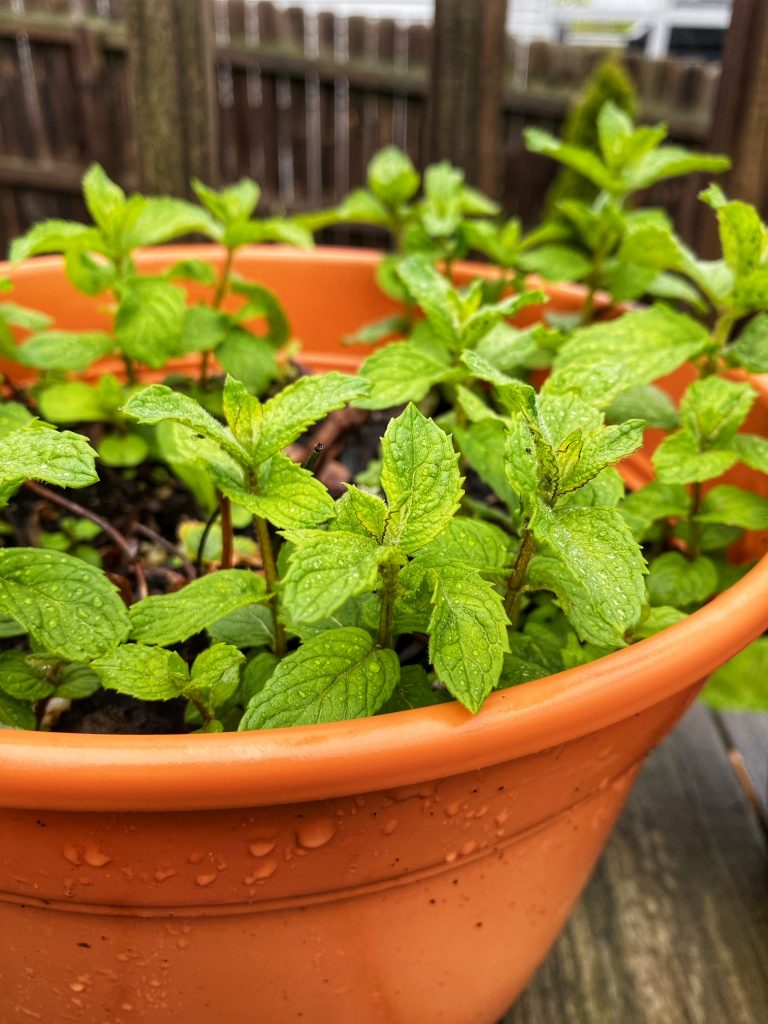
Our heirloom mint, from Emily Dickinson’s garden.

